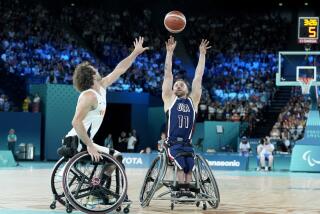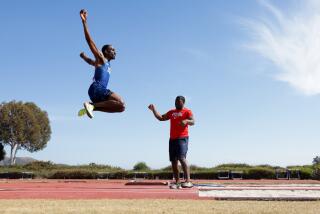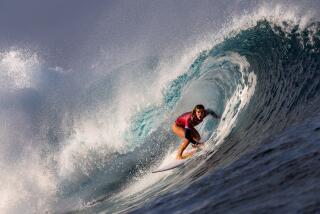Blind Catch a Wave at Surfing School
What does surfing sound like?
That question will be answered 24 ways when two dozen blind children and teen-agers from Los Angeles attempt to become wave jockeys in Malibu this week. They are participating in a special program offered by a local surfing school and the Braille Instituteâs summer camp.
The program, now in its third year, offers blind children a chance to learn how to catch waves with their bodies and their boards and enjoy a sport that is followed like a religion in certain areas of Southern California.
Ted Silverberg, who owns and operates Paradise Surfing Lessons in Malibu, was approached by the Braille Institute after he began giving lessons to handicapped youngsters several years ago. âThey just asked me if I could teach some blind children how to surf, and I told them that there was only one way to find out,â he said.
A tough sport for good athletes and often cruel to novices, surfing presents some particularly thorny problems for the blind. Imagine being propelled forward by a wave thatâs breaking behind you, not knowing whatâs in front of you and having no idea where the shore is once you fall in the water. Forget for a second that the water is the Pacific Ocean.
Unlike a sighted surfer who âgets stokedâ from catching a good wave, the same ride can cause a blind surfer to just get scared.
âThereâs no doubt that theyâre scared when they first try it, but we try to reassure them,â said Steve Lackey, assistant director at the Braille Instituteâs Youth Center. âThe goal is to let them overcome their fears.â
To help them achieve that goal, Silverberg and the surfing school instructors--Mikke Pierson, Bob Terry, Todd Roberts and Eric Tomooka--will stand on the boards with the students, guiding them through the twists and curls. The beginning rides will take place in shallow breakwater. Better swimmers will move on to the deeper areas as the lessons progress.
âThe awareness that blind children bring to surfing is just amazing,â said Silverberg, a surfing veteran of 15 years. âTheyâre so much more sensitive to motion and sound and even the temperature of the water. Some of them told me that surfing was like being on a roller coaster.â
Recreational Alternatives
Lackey said the Braille Instituteâs summer camp is designed to provide ârecreational alternativesâ for blind youngsters.
âSince they canât compete in sports with their sighted peers, we try to slightly modify sports activities so they can do them,â he said. âOne of the problems of being visually impaired is that a lot of the kids tend to become inactive. Weâre here to show them that they can do a lot of things, so we have them go rock climbing, water skiing, swimming and surfing.â
In surfing, the biggest problem is getting the youngsters oriented in the water so that they know where the waves are coming from and where they are in relation to other water jockeys and swimmers, Lackey said.
The surfing expedition is scheduled for 10 a.m. Thursday at an undetermined beach in Malibu. The site will depend on the size of the waves.
Lackey said the youngsters who participate in the program range in age from 7 to 18 and include several who attempted to ride waves last year. Silverberg said the lesson will include techniques on how to use âboogie boardsâ for body surfing and regular boards for stand-up surfing.
âItâs a lot of fun for everybody,â Silverberg said. âYou canât believe their faces when they get up on the board.â
More to Read
Sign up for The Wild
Weâll help you find the best places to hike, bike and run, as well as the perfect silent spots for meditation and yoga.
You may occasionally receive promotional content from the Los Angeles Times.






